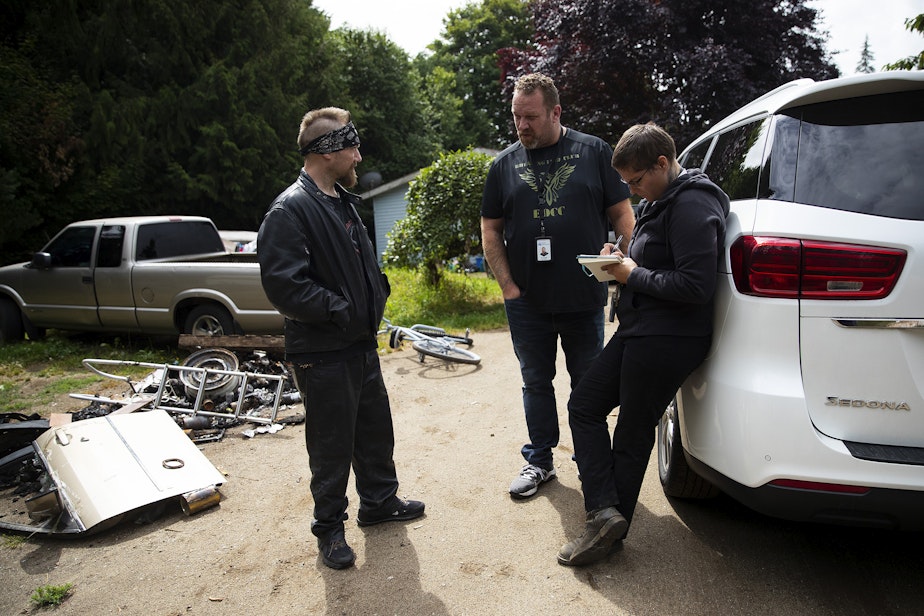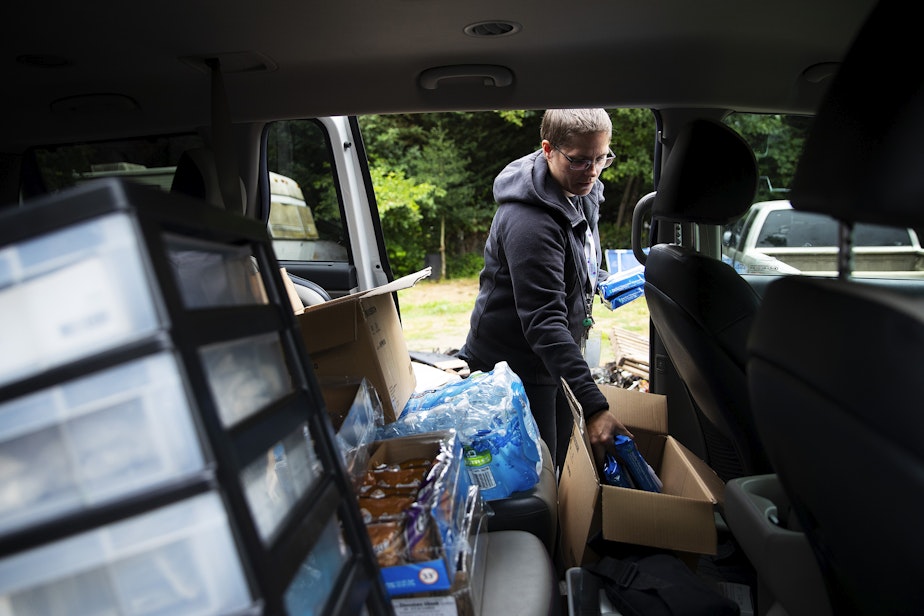From needles to pipes. Seattle outreach adapts to morphing drug crisis

Needle exchange workers in Western Washington noticed a surprising trend recently: Far fewer people wanted needles.
The Public Health – Seattle & King County syringe exchange saw their distribution drop by about half between 2021 and 2022, according to officials.
In Everett, Jessica Thornton, an outreach worker with South Pathways Syringe Services, said she and her colleagues have witnessed a similar decrease.
“It would be interesting. We would walk up and say, 'Hey, we're part of the syringe program,' and there'd be a chunk of people that would turn and walk away,” Thornton said.
Distributing needles has long been a way for outreach workers to make initial contact with people struggling with substance abuse, build relationships, and connect them with other resources and support.
Sponsored
But the rise of fentanyl addiction and the dramatic uptick in overdose deaths have changed the things people struggling with substance abuse need, and therefore what’s in the toolkits of the people who devote their lives to helping those people survive and remain healthy.
One of the biggest changes has been in the way drugs are used. While the majority of people with opioid use disorder used to inject drugs like heroin, many are now smoking fentanyl and other powerful drugs, like methamphetamine.
That means they don’t need needles; they need pipes.
King County began a pilot program earlier this year to provide a limited number of smoking supplies through their needle exchange. In the first five months, county officials say this service brought 163 new people to the exchange.
According to a report from the University of Washington published earlier this year, harm reduction programs across the state are reporting an unprecedented demand for safe drug-smoking supplies. But, at the time of the report, only about a third of the programs were offering such supplies.
Sponsored
At Sound Pathways, outreach worker Joe Dugan said the addition of clean smoking supplies to that organization’s repertoire was a necessary shift.
“We have to adapt, and then be able to be there to engage in that conversation with them,” Dugan said. “If needles aren't doing it, and more people are smoking, we need to bridge that gap."
The data also shows that 71% of people who received a pipe also engaged with at least one other service. In that sense, smoking supplies might be the new way for harm reduction services to make contact with people suffering from substance abuse and let them know about other resources.
“We're not going to change from a needle exchange to a pipes distribution program,” said Karen Hartfield, manager of the HIV, STI, and Hepatitis C program with Public Health – Seattle and King County. “But we are looking at ways that we can engage this population that is at such high risk for losing their lives.”
That’s because fentanyl, the new drug of choice, is potent, cheap, and deadly.
Sponsored
In 2022, 712 people in King County died from overdosing on the synthetic opioid. That’s almost a seven-fold increase from 2019, when 109 such deaths were reported countywide.
Thornton and her colleagues in Everett still carry sterile supplies for drug injections, along with things like body wipes, snacks, and kits to treat wounds. But they have added vital supplies to address the deadly dangers of fentanyl — things like fentanyl testing strips, so people can test the potency of drugs before using them, as well as the opioid overdose reversal drug, naloxone, which has already saved countless lives.

Joe Tinsley is the drug user health manager at Public Health – Seattle & King County. He works at the needle exchange in downtown Seattle.
At that downtown exchange site, Tinsley said people also have on-the-spot access to providers who can prescribe medication that can help curb opioid use disorder.
Sponsored
Tinsley compared the availability of complementary resources to someone who visits a website to buy kitty litter.
"And as soon as you click that in your cart, then all these other things pop up, like flashy toys, or kitty litter scoopers,” Tinsley said. “And then all of a sudden, the one thing in your cart is now a part of 20. So, I like to think that when people come in here, they might have one thing that they're looking to get, but because we've got so much under the roof, they can leave with so much more."
Harm reduction services are not new. Some programs have been running for decades. According to a University of Washington report, there are now roughly 40 harm reduction services across the state.
But the collision of two crises, the pandemic and the rise of fentanyl, meant a challenging and changing landscape for those working to help drug users find resources and get help.
While most needle exchange programs remained open during the pandemic, the threat of the virus forced changes.
Sponsored
Spaces that used to serve as gathering sites, or places for people to rest while they picked up supplies and accessed services, suddenly had strict restrictions on the number of people allowed in at one time.
Thornton and Dugan say the Sound Pathways mobile service kicked up a notch during the pandemic, visiting people in their homes, in parking lots, and in encampments.

While parked in the dirt driveway of a home in a rural area outside Everett, the two recently met a man named Robert who was visiting the tenants.
Robert, who asked to only use his first name to protect his privacy, said he’d quit using drugs but needed help with housing. They handed over their contact details and walked him through the various services he could try.
As other services closed during the pandemic, harm reduction programs found themselves picking up the slack.
Joe Tinsley with the county exchange in Downtown Seattle said one thing that was striking to him was how many people came looking to fulfill basic needs.
They needed clothes, food, and hygiene supplies. It wasn’t in the budget, so Tinsley said he and his colleagues took it upon themselves to bring in what they could and solicit donations from family and friends.
“I think I cleaned out my closet three or four times during the pandemic,” Tinsley said. “Staff took it upon themselves to buy food, to buy socks and underwear.”
While many advocates and experts say the harm reduction model is more important than ever to help curb mortality rates, it is not entirely uncontroversial.
Some people worry the model enables people to continue using drugs and say resources would be better spent on abstinence-based treatment models.
However, service providers say both are needed.
“It is important to meet our people where they are,” said Esther Lucero, president and CEO of the Seattle Indian Health Board.
Lucero said the idea of harm reduction is built into all the services the Seattle Indian Health Board provides.
“If they're in a space where they require harm reduction services, we should have that available to them. If they're in a space where they're ready to enter into an abstinence-based program, we should have that ready for them,” she said. “We cannot just decide to pick and choose.”
Lucero said funds are needed for the entire continuum.
Caleb Banta-Green, director of the University of Washington’s Center for Community-Engaged Drug Education, Epidemiology and Research, said that was especially the case when it comes to harm reduction programs and the ability to expand their reach.
“For harm reduction programs to meet the need that is grossly unmet, they need to be able to expand their staffing. They need to be able to pay staff and have good spaces that are open adequate hours and have a broad array of services,” he said.
Banta-Green is a strong proponent of a model that would essentially expand on the way harm reduction works now, adding even more services to a single site.
Dubbed health engagement hubs, these sites would have behavioral health services, physical health services, social services, and more.
“Something for everybody every day,” Banta-Green said. “That’s the bottom line of what we’re trying to create."
Legislation passed this year funded a pilot program for two such hubs. Banta-Green estimates almost 40 would be necessary across the state to meet the need.

